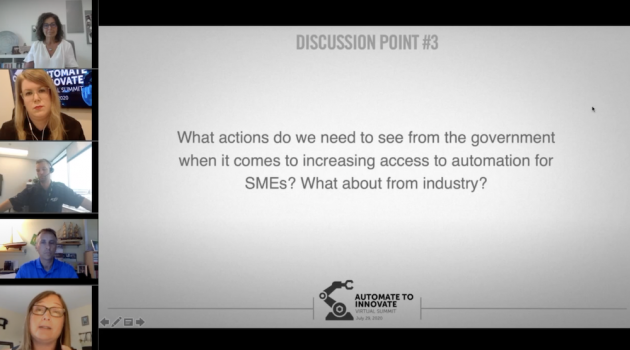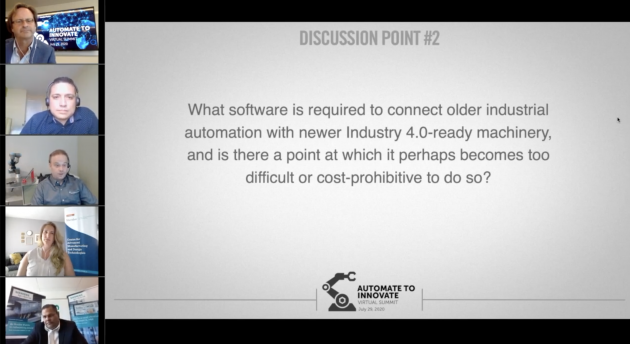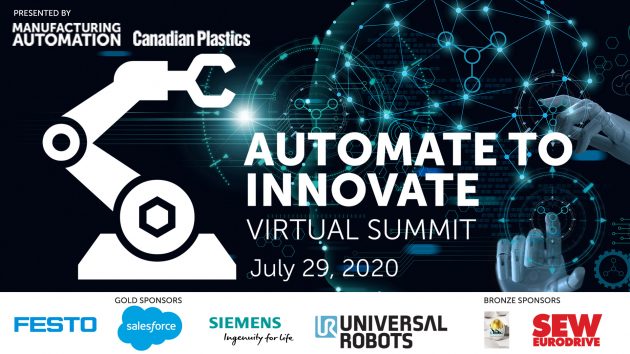
Five steps to plan and pay for automation: Automate to Innovate event recap
August 11, 2020
By
Kristina Urquhart
Our first-ever virtual summit, co-hosted with Canadian Plastics, yielded best practices for automation implementation for SMEs coming out of the COVID-19 crisis

Over the past few months, we’ve discussed extensively the impact COVID-19 is going to have on the industrial automation sector, and how manufacturing supply chains are going to change because of the crisis.
The resounding sentiment from industry experts, association representatives and senior executives was that implementation of automation is going to ramp up much more rapidly than previously expected, because labour shortages, increased safety measures and supply and demand fluctuations now require it for businesses to stay competitive.
So we know what will happen, but how do we make it happen? That was our question when we partnered with our colleagues at Canadian Plastics to stage the Automate to Innovate Virtual Summit in partnership with Annex Business Media on Jul. 29.
After months of manufacturers being in crisis management mode, we wanted to get the automation conversation reignited – or, in some cases, started – for small and medium-sized businesses, in the context of COVID-19.
Automate to Innovate focused on the “how” of automation, with the first set of sessions exploring how to plan for and install it, and the second set outlining how to pay for it.
“Senior management has gone from simply reacting to this crisis [to] thinking longer-term,” said panelist Shelley Fellows, chair of the Automate Canada association, during the summit. “They’re thinking recovery; they’re thinking investment into their operations where automation has a role.”
The live event included three presentations on automation solutions, a panel discussion on automation in the era of Industry 4.0, a presentation on government funding options, and a second panel discussion on the cost of implementation – plus an on-demand session on how to select an industrial robot.
Here are five key takeaways:
1. Assess your problem
Think about what tasks could be automated easily and that will bring high value to your company. It might be a dangerous job on the factory floor, a repetitive data entry function or a task that would free up a skilled worker to do more complex work.
“My advice would always be – pre-COVID but maybe now even more in COVID times – just know the problem you’re trying to fix and the objectives of your project,” said Blair de Verteuil, vice-president, operations, life sciences at ATS Automation. “Whether it’s cost-centric – unit cost reduction, a reduction in changeover time – your competition is edging you out.”
Assessing your problem will also help to pinpoint what is most necessary to start with as your business recovers from COVID-19 shutdowns, the panelists said. A poll held during the event indicated that 40 per cent of attendees were most concerned about low cash flow over recent months as a barrier to implementation.
David Jeffrey, regional vice-president, Central Canada at Salesforce, advised that once SMEs identify the problem they need to solve with automation, they must quantify it. “You don’t want to be solving a $10 problem with a $100 solution,” he said.
“Cash flow obviously is a difficult thing to get over, but we see status quo as being the strongest gravitational force. The ability to […] understand the problem and have a vision about what you’re going to do to change that, and how it might impact everyone, is very critical.”
Rather than coming at the problem by trying to find automation that fits your current cost needs, figure out the appropriate solution first. Automation integrators and OEM suppliers are there to help manufacturers develop solutions, and often won’t charge for consultations, said de Verteuil.
“They may even help you build a TCO model. And then you can start to seek your financing options. It’s really difficult to convince anyone – internal to the organization, lenders, grant decision makers – to pony up cash unless you really know what you’re solving and you have a really solid business case.”
2. Develop a funding plan
Once you know your problem, the funding route becomes clearer, said Bernadeen McLeod, president of Mentor Works, who gave a 20-minute presentation on how to select and leverage federal government funding. She emphasized that knowing your business challenges will help you divvy up the funding opportunities into manageable pools.
“Identify your project. Is it assessment and analysis money that you need, is it training money that you need? Is it consulting and implementation and execution money?” she asked. “Once you identify where you want to work with a vendor, then the program from the government is so much easier to identify.”
McLeod pointed out a number of programs for capital investment, training and implementation. For manufacturers who need to stabilize their business after COVID-19, there’s the Regional Relief and Recovery Fund, which offers the opportunity for a $500,000 loan if a business shows its operating expenses and shortfall.
“I want you to get in the habit of picking a federal program and then stacking it with a provincial program that is a lookalike,” she advised.
“It’s really difficult to convince anyone to pony up cash unless you really know what you’re solving and you have a really solid business case,” said de Verteuil.
3. Set up a phased approach
“If done right, financial returns on automation can be absolutely enormous,” said de Verteuil. “My recommendation would be to be ambitious with that big-picture thinking, but start small. Think scalable automation, phased approach – consider, is this new technology to the company?”
Shelley Fellows of Automate Canada recommended a digital simulation as a cost-effective way to test and determine whether an automation application will work before making a major investment.
She said the automation companies that have a good controls team can conduct a virtual representation to show how concepts will work, “so the customer has a really strong sense of what capabilities the equipment is going to attain before one single piece of wire is purchased or one single robot is placed on the floor.”
4. Expand with data
Once you have a plan, think about how you can use data to gain insight into your operation, which will help you achieve the perennial goals of reducing cost and waste, said Asghar Rizvi, director of automation and motion for Siemens Canada. Artificial intelligence and machine learning are big terms that can feel intangible, but ultimately, they are tools that, when used correctly, help drive a profit.
“As more data is available, as computing capabilities increase, it’s really going to open up the way that we work with automation, and not just use automation to replace the work that we do,” said Michelle Chrétien, director of the Centre for Advanced Manufacturing and Design Technologies at Sheridan College.
In the past, this daunting challenge has often led to a throwing-up-of-the-hands for SMEs and a return to status quo, but COVID-19 has changed the game.
The challenging part for SMEs, however, may be bringing their legacy systems into the Industry 4.0 era. Some machines may only require an IoT-enabled sensor, but for others, connectivity may be more complicated.
“There isn’t one solution to rule them all, and right now what predominates is bit of a piecemeal approach in terms of patching together things,” Chrétien said. “That’s an incredibly time-consuming operation, which basically puts it out of the realm of possibility for many SME manufacturers who just don’t have the time or the staff or perhaps even the expertise to approach that.”
Santiago Olmedo, customer solutions engineering manager at Festo, reiterated this. “If you consider an older automation system running an outdated protocol – for example, DeviceNet – unless we could integrate a gateway to transfer the data to a more modern fieldbus, say Ethernet/IP, it may be rather expensive to try to overhaul the entire system to work with Ethernet/IP devices.”
In the past, this daunting challenge has often led to a throwing-up-of-the-hands for SMEs and a return to status quo, but COVID-19 has changed the game.
“It’s always been a matter of time and money,” said de Verteuil. “Now, it’s a recognition that change is necessary.”
5. Consider your customer
Embracing that change is crucial to satisfying the customer – and amid all of the planning for automation, the panelists stressed to never lose sight of that.
“Manufacturers are [now] working in an environment where production runs are high mix and low volume,” said Michael Phillips, pre-sales engineer at Universal Robots, citing the move to online shopping as a major factor for the shift.
“Manufacturing lines themselves have to become a little bit more agile and able to respond to information that they pull down from higher-level systems,” he said. “This in turn means they’re much more flexible. They can execute any of the product lines that the customer may want.”
David Jeffrey of Salesforce said the effect of the COVID-19 crisis on the supply chain has highlighted the increasing expectations of business-to-business customers when it comes to price, value, service and other measures of competitiveness. “Now’s not the time to create a worse customer experience,” he said. “So, if your supply chain and technologies don’t support the customer expectations, especially now when those are so critical, you’re really exposing yourself.”
“Now’s not the time to create a worse customer experience,” said Jeffrey.
Whether an SME’s plan initially involves automating factory processes or tracking product lifecycle data to adjust production on the fly, be mindful of how all processes will eventually integrate. “We need to understand how to make our customers’ lives easier,” said Rizvi. “This pandemic will pass, but it will change how our executives will review their readiness for real-time events. Real-time data will play a very important role.”
For more insights from the Automate to Innovate Virtual Summit, you can still register and watch the recordings for free.
Thanks to our event sponsors for their support: Festo, Salesforce, Siemens, Universal Robots, KINITO Support Systems Inc., and SEW Eurodrive.
Advertisement
- Martinrea loses $146.9 million in Q2 on 51 per cent drop in sales due to COVID-19
- Hammond releases flame-retardant DIN rail enclosures


